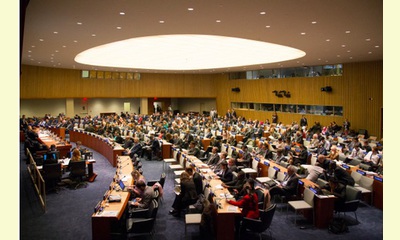|
|
7 Things You Need to Know about the Resolution on Women and Disarmament from UNGA First Committee
an article by Lorey Campese, Control Arms Blog
During the UN General Assembly First Committee, a
resolution was adopted this year on the role of
women and broader international security. Of 63
resolutions adopted, it was easily the most hotly
debated with multiple meetings scheduled nearly
every week to negotiate the text of the resolution. 
click on photo to enlarge
The resolution achieved substantive progress from
previous editions and called for real action. Thatís
something you donít always see in resolutions.
Here are 7 things you need know about First
Committeeís hottest resolution this year:
1. The rise of a resolution
The General Assembly has seen the Women,
disarmament, non-proliferation and arms control
resolution before. It was introduced three times in
the past four years. But this yearís edition looked
much different. It took general and vague language
that easily gathered consensus in from 2010-2013
and gave it some teeth. At the United Nations, when
you get agreement on anything, itís easy to simply
leave it alone and say the same thing year after year.
The leaders for this resolution chose a different path
and had to use serious diplomacy and hard work to
achieve the results. Thatís a small example of how
change happens in a system that, at times, appears
to be allergic to it.
2. Arms Trade Treaty impact
During informal discussions, one diplomat (that
doesnít like the ATT very much) argued that they
have a problem with ďany reference to the Arms
Trade TreatyĒ in the resolution. Iím sure they know
that the ATT is the first piece of international treaty to
ever mention gender-based violence. But that
historic bit of info takes a back seat to politics from
time to time. The ATT was the center of discussion in
every consultation on the resolution, but progressive
leaders stood firm and ensured that the Arms Trade
Treaty had its place in a resolution where it truly
belonged. Perhaps even more interesting is that a
handful of countries that didnít vote in favor the
ATTís adoption a year and a half ago voted to KEEP
the reference in this resolution. Countries co-
sponsoring the resolution also included some ATT-
abstainers such as Bolivia. These small shifts in
voting are indicative of progress for the lifesaving
treaty.
3. Risk assessments
Not only was there a reference a reference to the
ATT, but the resolution also called for ďnational risk
assessment criteria to facilitate the prevention of
arms to commit violence against women.Ē The
translation from legalese to English is as follows: the
ATT says that countries have to take into account
the risk of weapons being used to commit gender-
based violence, before they can authorize a transfer.
This resolution encourages countries to develop risk-
assessment criteria. A small step, but one thatís
important enough to save lives and hold violating
governments accountable.
(This article is continued in the discussionboard)
|








|
DISCUSSION
There is no question yet associated with this article.
* * * * *
LATEST READER COMMENT:
(The following is continued from the main article listed above.)
4. 98 co-sponsors
The resolution was cosponsored by nearly 100 countries. For those counting, thatís more than half of the entire world. A co-sponsorship signals two things: that the government is firmly behind all of the provisions of the resolution AND that they are guaranteed to vote yes on it. Any time you have any action at the UN with half the membership on board, you have to call that a win.
5. Small States, big impact
ATT negotiations showed that you didnít have to be an economic or political powerhouse to change the world. Sure, the US, China, Russia, the UK, and others flexed their muscle, but countries like New Zealand, Iceland, and Costa Rica also showed that everyone has an important role to play when it comes to saving lives. Trinidad and Tobagoís leadership in leveling the playing field for women in disarmament and arms control shows once again that small states can have massive impact at the United Nations.
6. . ...more.

|
|









